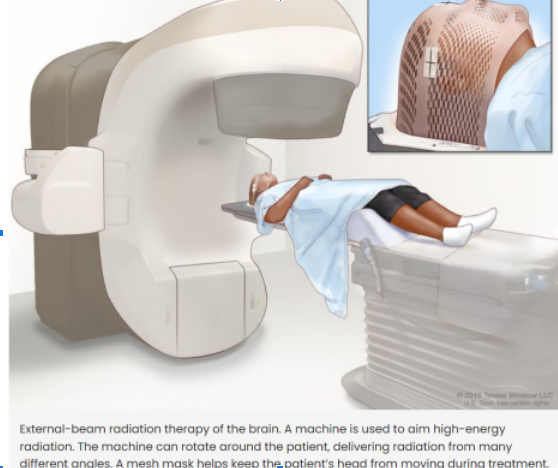Brain Tumors
Home » Specialties » Brain Tumors

Brain Tumour
The brain controls many important body functions. The spinal cord connects the brain
to nerves in most parts of the body. There are many types of tumors that can originate
from various tissues of the brain and spinal cord. Some examples are: Astrocytomas,
Oligodendrogliomas, Meningioma, Pineal tumors, Craniopharyngioma, Acoustic
Schwanomma, etc.
Similarly many times many tumors from other parts of the body can spread to the
brain. These are called metastases.Metastatic brain tumors are more common than
primary brain tumors.The most common organs from which cancers spread to brain
are: Lung, Breast, Kidney, Melanoma, Colon, etc.
Brain Tumor Symptoms
- Morning headache or headache that goes away after vomiting .
- Seizures .
- Vision, hearing, and speech problems.
- Loss of appetite .
- Frequent nausea and vomiting.
- Changes in personality, mood, ability to focus, or behavior.
- Loss of balance and trouble walking.
- Weakness.
- Unusual sleepiness or change in activity level.
Spinal Cord Tumor Symptoms
- Back pain or pain that spreads from the back towards the arms or legs.
- A change in bowel habits or trouble urinating .
- Weakness or numbness in the arms or legs.
- Trouble walking.
- Frequent nausea and vomiting.
Diagnosing a brain tumor:
1. Physical examination includes a complete neurological examination, Eye
checkup, or hearing tests.
2. Imaging of brain: Can be done by a CT scan, MRI Scan or some specific PET
scans also
3. Biopsy : Tissue diagnosis is required to classify and grade the tumor.This can be
via a stereotactic biopsy or an open surgery. This is performed by a
neurosurgeon.
4. Histopathology: After examining the tissue under a microscope certain tests
might need to be done to further classify and prognosticate the tumor. These
tests are Immunohistochemistry (IHC) & Cytogenetic studies to assess genetic
mutations.
Treatment Overview
There are different types of treatment for patients with adult brain and spinal
cord tumors. These are:
- Surgery: Usually the first choice treatment. Required for decompression, biopsy or maximal removal of tumor.
- Radiation Therapy: Radiation therapy is a cancer treatment that uses high-energy x-rays or other types of radiation to kill cancer cells or keep them from growing. External radiation therapy uses a machine outside the body to send radiation toward the area of the body with cancer. There are various techniques of delivering precise radiation beams to the tumor. These include: Conformal RT, IMRT, IGRT, and Sterotactic Radiosurgery.
- Chemotherapy:Cancer treatment that uses drugs to stop the growth of cancer cells.

Treatment of Metastatic Brain tumors:
Treatment of tumors that have spread to the brain from another part of the body may
include the following:
- Radiation therapy to the whole brain with or without surgery .
- Radiation therapy to the whole brain with or without stereotactic radiosurgery .
- Stereotactic radiosurgery.
- Chemotherapy , if the primary tumor is one that responds to anticancer drugs . It may be combined with radiation therapy.
Stereotactic Radiosurgery
Stereotactic radiosurgery (SRS) uses many precisely focused radiation beams to treat
tumors and other problems in the brain, neck, lungs, liver, spine and other parts of the
body.
It is not surgery in the traditional sense because there’s no incision. Instead, stereotactic
radiosurgery uses 3D imaging to target high doses of radiation to the affected area with
minimal impact on the surrounding healthy tissue.
Like other forms of radiation, stereotactic radiosurgery works by damaging the DNA of
the targeted cells.
Stereotactic radiosurgery of the brain and spine is typically completed in a single
session. Body radiosurgery is used to treat lung, liver, adrenal and other soft tissue
tumors, and treatment typically involves multiple (three to five) sessions.
Different types of technology can be utilised to deliver the SRS treatments:
1. Linear accelerators(LINAC): These machines utilise highly conformal photon
beams to target the tumor. LINAC machines are also known by the brand name
of the manufacturer, such as CyberKnife and TrueBeam.
2. Gamma Knife machines use 192 or 201 small beams of gamma rays to target
and treat cancerous and noncancerous brain abnormalities.
3. Proton beam therapy (charged particle radiosurgery) is the newest type of
stereotactic radiosurgery and is available in only a few centers across the globe.
Indications of SRS
Around 50 years ago, stereotactic radiosurgery was pioneered as a less invasive and
safer alternative to standard brain surgery (neurosurgery),Since then, the use of
stereotactic radiosurgery has expanded widely to treat a variety of neurological and
other conditions, including:
1. Malignant brain tumors including brain metastasis, Recurrent primary brain
tumors like gliomas.
2. Benign Brain tumors like Meningiomas, Acoustic Schwannomas, Pituitary
adenomas, Craniopharyngiomas, Arteriovenous Malformations (AVM),Skull base
tumors like Chordomas, Paragangliomas. Although these tumors are not
malignant they have a tendency to recur after primary surgery and hence may
need treatment in upfront or recurrent settings.
3. Functional radiosurgery indications: These are not directed at a particular tumor
but delivering high doses of radiation brings relief from the particular
condition.Examples are Trigeminal neuralgia, Recurrent seizure disorder, tremors
associated with certain disease like Parkinson’s and essential tremor.